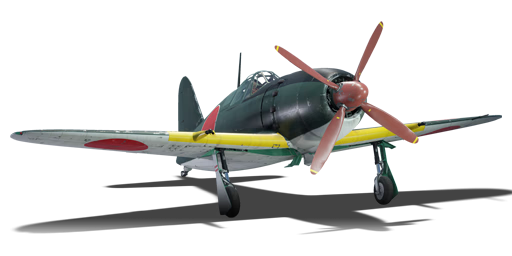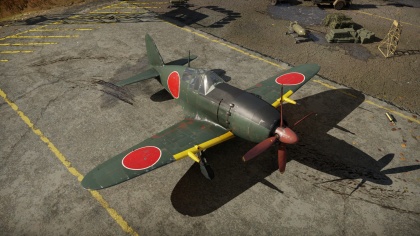J2M5 30mm
Contents
| This page is about the aircraft J2M5 30mm. For other uses, see J2M (Disambiguation) |
Description
The J2M5 Raiden is a premium Rank IV Japanese fighter
with a battle rating of 5.7 (AB), 5.0 (RB), and 4.7 (SB). It was introduced in Update 1.51 "Cold Steel" and costs 3,850 Golden Eagles.
The Premium J2M5 with 2 x 30 mm cannon sits at a favorable BR of 4.7. Unlike its other Naval brethren in the Japanese tech tree, the Raiden possesses a top speed rivaling that of the P-51 D-5 Mustang. Although a stubby and small aircraft, the Mitsubishi J2M Raiden can be considered one of the best Japanese fighters in War Thunder. Unlike its predecessors, the premium variant of the J2M5 features a deadly armament of two 30 mm cannons. However, the main advantage the Raiden has over its Allied counterparts is its climb rate. In Realistic Battles, the J2M5 can climb to higher altitudes very quickly, especially when given an air start. This facet of the Raiden's performance is particularly exemplified in the J2M5, the last in-game variant of the Raiden that features the greatest performance of the series. This is partially due to its mechanically-driven supercharger which allows the J2M5 to perform at altitudes once thought impossible by Japanese engineers. Once at a high altitude, it becomes possible to choose when, where, and who you want to fight. The premium J2M5's 30 mm cannons may initially seem rather lackluster due to the low ammo count but they do an impressive amount of damage upon a successful hit. Generally, the J2M5 performs similarly to the early Fw 190 A variants, having a deadly armament, good roll rate, low top speed, but higher climb rate. The J2M5 differs from this rule slightly as it was built for speed and high-altitude performance. The Raiden is best used as an energy fighter - instead of "turning and burning", or losing all built up speed in turns, attack enemies from a higher altitude and then regain that altitude once the attack has been delivered. The J2M5 excels at Boom & Zoom due to its high rate of climb, deadly armament, and high altitude characteristics.
Sharing this role with other "energy fighters" such as the Fw 190 D-13 the Raiden's main downside is its lack of maneuverability. Similar to its earlier mentioned German counterpart, the Raiden struggles to beat enemies in turn fights, especially Spitfires. If caught in a sticky situation, the Raiden pilot may choose to dive away or seek help from teammates. Trying to fight an enemy Spitfire in a turn battle with any J2M is a terrible idea, unless the enemy aircraft is damaged or many teammates are nearby. Moreover, the J2M's high speed maneuverability is very poor; often, it becomes a matter of life and death when pulling out of a high speed dive as the Raiden's elevator authority at high speeds is lacking. The entire aircraft locks up at excess speeds of 645 KPH/400 MPH. It can be very difficult to pull out of a dive, roll, or turn when at high speeds with the J2M. The Raiden's maneuverability is more or less on par with its enemies in simulator battles, for the most part.
The Raiden pilot may also find him or herself outclassed at extreme altitudes by aircraft such as the Ta 152. All these aircraft have to do to avoid the J2M5 is dive away and build up speed. Fortunately, this aircraft has a deadly pair of 30 mm cannons. With good aim and practice, it is possible to "snipe" enemies from upwards of a kilometer away with these weapons. Overall, the Raiden is best used as a surprise attack, high altitude, high damage output fighter. Where it lacks in the maneuverability category, it makes up for in armament and rate of climb.
General info
Flight Performance
| Characteristics | |||||||
|---|---|---|---|---|---|---|---|
| Stock | |||||||
| Max Speed (km/h at 6,580 m) |
Max altitude (meters) |
Turn time (seconds) |
Rate of climb (meters/second) |
Take-off run (meters) | |||
| ABN1K2-J | RB | AB | RB | AB | RB | ||
| 585 | 569 | 11500 | 20.2 | 20.6 | 12.9 | 12.9 | 300 |
| Upgraded | |||||||
| Max Speed (km/h at 6,580 m) |
Max altitude (meters) | Turn time (seconds) | Rate of climb (meters/second) |
Take-off run (meters) | |||
| AB | RB | AB | RB | AB | RB | ||
| ? | ? | 11500 | ??.? | ??.? | ??.? | ??.? | 300 |
Details
| Features | ||||
|---|---|---|---|---|
| Combat flap | Take-off flap | Landing flap | Air brakes | Arrestor gear |
| ✓ | ✓ | ✓ | X | X |
| Limits | ||||
|---|---|---|---|---|
| Wing-break speed (km/h) |
Gear limit (km/h) |
Combat flap (km/h) |
Max Static G | |
| + | - | |||
| 820 | 350 | 520 | ~12 | ~9 |
| Optimal velocities | |||
|---|---|---|---|
| Ailerons (km/h) |
Rudder (km/h) |
Elevators (km/h) |
Radiator (km/h) |
| < 420 | < 420 | < 460 | > 280 |
| Compressor (RB/SB) | ||
|---|---|---|
| Setting 1 | ||
| Optimal altitude | 100% Engine power | WEP Engine power |
| 2,800 m | 1,510 hp | 1,812 hp |
| Setting 2 | ||
| Optimal altitude | 100% Engine power | WEP Engine power |
| 6,800 m | 1,450 hp | 1,740 hp |
| Setting 3 | ||
| Optimal altitude | 100% Engine power | WEP Engine power |
| 7,200 m | 1,400 hp | 1,680 hp |
Survivability and armour
- 70 mm Bulletproof glass - Armored windscreen
- 8.5 mm Steel plate in pilot's headrest
Armaments
Offensive armament
The J2M5 30mm is armed with:
- 2 x 30 mm Type 5 cannons, wing-mounted (42 rpg = 84 total)
Suspended armament
Main article: Bombs
The J2M5 30mm can be outfitted with the following ordnance:
- Without load
- 2 x 60 kg Navy Type 97 Number 6 ground bombs (120 kg total)
Usage in the battles
The premium variant of the J2M5 wields two 30 mm Type 5 cannons in the wings. The stock belts are particularly lackluster but since this aircraft comes furnished with all modules upon purchase, any other belt can be selected. The best anti-air belts for these weapons are the "tracers" belt as it is comprised entirely of HE-T rounds.
For ground attack, the J2M5 can equip two 60 kg bombs under the wings. While not the biggest, these bombs can help a team win a match, especially in arcade battles. The J2M5 can also wield armor piercing ground targets ammunition (solid practice rounds) for its 30 mm cannons which can easily destroy light and medium tanks.
Manual Engine Control
| MEC elements | ||||||
|---|---|---|---|---|---|---|
| Mixer | Pitch | Radiator | Supercharger | Turbocharger | ||
| Oil | Water | Type | ||||
| Controllable | Not controllable | Not controllable | Not controllable | Separate | Not ontrollable | Not controllable |
Modules
| Tier | Flight performance | Survivability | Weaponry | |
|---|---|---|---|---|
| I | Fuselage Repair | Radiator | ||
| II | Compressor | Airframe | Offensive 30 mm | |
| III | Wings Repair | Engine | ||
| IV | Engine Injection | Cover | New 30 mm Cannons | |
- This aircraft comes furnished with all modifications upon purchase.
Pros and cons
Pros:
- Decent top speed
- Climbs very well
- Has generally good dive characteristics
- Good energy retention
- 12 mm armor plate behind windscreen
- Good roll rate at lower speeds
Cons:
- Very poor high speed performance
- Extremely limited ammunition
- Prone to engine and fuel fires
- Doesn't turn well
- Elevator doesn't respond well, especially at high speeds
- Lack of armor around fuel tanks or engine
History
The J2M Raiden was the result of the Japanese Navy request for an interceptor, the need of which became ever apparent after the experiences with the American raid on the Japanese homeland shorty after the attack on Pearl Harbor (Doolittle's Raids). The Chief Designer was Jiro Horikoshi, who also designed the famous A6M fighter. However, unlike the A6M, the J2M was geared for a completely different role, focusing more on rate of climb and speed than range and maneuverability. The Raiden had only a limited range and was solely used as an interceptor.
The most important feat of arms came with the American B-29 raids over Japan, where the J2M Raiden proved to be a real threat to the bombers - the J2M was well armed, fast and the large pools of ammunition meant that despite a small number of Raidens, the four squadrons operating them were credited with the destruction of 21 Superfortresses during the later months of August 1944 to the end of the war.
Furthermore, the J2M2 saw limited action in the Philippines, although it was largely ineffective.
Media
An excellent addition to the article will be video guides, as well as screenshots from the game and photos.
Read also
Links to the articles on the War Thunder Wiki that you think will be useful for the reader, for example,
- reference to the series of the aircraft;
- links to approximate analogues of other nations and research trees.
Sources
Paste links to sources and external resources, such as:
- topic on the official game forum;
- page on aircraft encyclopedia;
- other literature.
| Japan fighters | |
|---|---|
| Navy | |
| Carrier-based fighter | |
| A5M | A5M4 · Hagiri's A5M4 |
| A6M | A6M2 mod. 11 · A6M2 · A6M3 · A6M3 mod. 22 · A6M3 mod. 22Ko · A6M5 · A6M5 Ko · A6M5 otsu · A6M5 Hei · A6M6c |
| A7He | A7He1* |
| A7M | A7M1 (NK9H) · A7M2 |
| Land-based Fighter | |
| J2M | J2M2 · J2M3 · J2M4 Kai · J2M5 · J2M5 (30 mm) |
| J6K | J6K1 |
| J7W | J7W1 |
| N1K-J | N1K1-Ja · N1K2-J · N1K2-Ja |
| Fighter seaplane | |
| N1K | N1K1 |
| A6M-N | A6M2-N |
| Army | |
| Ki-10 | Ki-10-I · Ki-10-I C · Ki-10-II · Ki-10-II C |
| Ki-27 | Ki-27 otsu · Ki-27 otsu Tachiarai |
| Ki-43 | Ki-43-I · Ki-43-II · Ki-43-III otsu |
| Ki-44 | Ki-44-I · Ki-44-I 34 · Ki-44-II otsu · Ki-44-II hei |
| Ki-61 | Ki-61-I ko · Ki-61-I otsu · Ki-61-I hei · Tada's Ki-61-I hei · Ki-61-I tei · Ki-61-II Otsu Kai |
| Ki-84 | Ki-84 ko · Ki-84 otsu · Ki-84 hei |
| Ki-87 | Ki-87 |
| Ki-94 | Ki-94-II |
| Ki-100 | Ki-100 · Ki-100-II |
| Other countries | ▅F4U-1A · ▅P-51C-11-NT · ▅Bf 109 E-7 · ▅Fw 190 A-5 |
| *Imported designation of the He 112 (A6M was in development - A7M would take A7 designation after the cancelation of the A7He) | |





